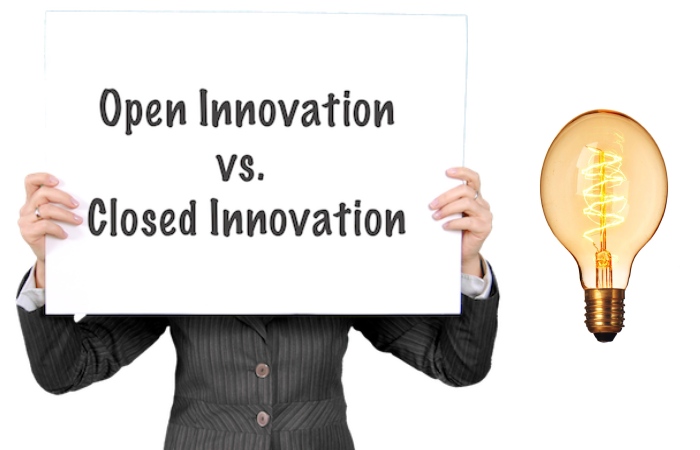
Open Innovation – Definition, Origin, Open vs. Closed Innovation, and More
Table of Contents
Open Innovation Definition
Open innovation consists of an innovation management model based on collaboration with people and entities outside the company. In this sense, open innovation challenges represent a break with internal knowledge silos and the secrecy traditionally associated with business R&D.
To embrace open innovation, the company has to recognize the opportunity to co-create with outside professionals or organizations and also be willing to share the benefits of such collaboration.
This ref-reflected various forms of collaboration between organizations or individuals, such as alliances, research chairs with universities, competitions through crowdsourcing.
Open Innovation: The Origin
Collaboration and co-creation have always existed, perhaps since humans began trading or since the craft industry adopts know how other regions or cultures.
Cisco may be the great pioneer of open innovation. Its acquisition strategy to make hardware and software compatible led it to increase in the late 1990s. By focusing on the market, this innovating strategy made Cisco outperform other companies such as Bell Labs or Lucent. We’re unable to transfer a significant investment in new technology to business growth.
Another of the initiators, without a doubt, is the pharmaceutical company Eli-Lilly with its head of R&D strategy at the helm. In an industry of million-dollar investments and success rates below 10%, this company considered in the year 2000 how to take advantage of collective intelligence through the Internet. E.Lilly is born the first online open innovation platform to connect with world scientific knowledge. Subsequently, this platform gives rise to Innocentive, a spin-off of Eli Lilly, which offers to accelerate the development of products mainly for the pharmaceutical and consumer products sector.
The third protagonist is Procter & Gamble, creating Connect & Develop, new product innovation and development model. Its main objective is to help P & G’s maintain annual revenue growth of $ 2B, sustaining its investment in R&D. It is Procter who takes this open model of innovation to its maximum expression, reaching 50% of innovations from outside and increasing the productivity of its R&D by 60%.
The use of the term Open Innovation attributes to Henry Chesbrough, Associate Professor and Director of the Center for Open Innovation at the University of California Haas School of Business.
Open vs Closed Innovation

The company uses innovation to generate and apply knowledge obtaining business results through new products and services, new business models, and more efficient operations.
Traditionally, some companies have innovated with their resources. The main reasons are the traditional lack of business orientation of the scientific community and protecting company assets.
That is why companies have traditionally prioritized the volume of resources, the number of projects, and investments in innovation. It is common to find large research areas or projects with numerous resources that generate their knowledge in organizations with closed innovation—the more, the merrier.
In these organizations, innovation measures using ratios such as the famous percentage of investment in R&D over sales. However, it’s well known that these isolation ratios only reflect the volume of investment, not the business results they generate.
Today, with the speed at which technology evolves, in companies that apply closed innovation models :
The knowledge generated is usually not complete. The contribution of external sources is critical today due to the speed of technological development and the lower barriers to entry.
Sometimes that knowledge does not reach commercialization, sometimes because it does not respond to market needs, and sometimes because it is obsolete or because of a change in business priorities.
Maintaining resources and budgets year after year is prioritized, and external innovation sees as a competitor; hence the famous “Not invented here.”
More recently, the so-called open innovation has emerged that encourages companies to use the knowledge outside their borders. Thus, relationships between companies, universities, technology centers, and other resources that provide more knowledge promote.
This innovation was born at the beginning of the century, fundamentally due to the opportunity offered by the Internet to connect with any part of the world easily.
In those organizations where open innovation use:
It collaborates with external knowledge generators as one of the pillars of innovation.
The internal organization organizes to connect and integrate internal teams with sources of superficial knowledge.
Internal innovation also exists, but it focuses on creating knowledge that does not live outside and as long as it can commercialize.
To this day, open innovation has been adopted by many companies globally to accelerate innovation processes, reduce risk, and do more with less.
The Advantages of Open Innovation

As Chesbrough points out in Forbes, open innovation offers companies a way to access knowledge and experience beyond their internal resources. Doing this can unlock many benefits.
Expanding the Pool of Ideas
Open innovation gives companies and organizations the ability to access new (and sometimes left-field) ideas for new products and services.
As Chesbrough notes, “Useful knowledge today is widely distributed, and no company, no matter how capable or large, can effectively innovate on its own.”
By expanding the network, companies can end up with solutions they would never have thought otherwise. For example, Starbucks may never have created the humble cake pop on its own.
In companies of all sizes, groupthink can limit the way companies identify new ideas for products and services. By inviting a broader range of viewpoints, companies can find novel solutions to complex problems.
Reduce Innovation Costs
Smart thinkers tend to be expensive. With open innovation, companies can access new ideas without including a new division of engineers and developers on their payroll.
However, companies still need to reward great suggestions. If you invite people to submit ideas, you need to create the right incentives for people. Such as cash prizes, sales shares, or professional recognition.
Get to Market Faster
Open innovation can significantly accelerate product development. By asking a broader group of people to contribute their ideas and expertise. Companies can identify and solve problems much faster and refine their products.
This is particularly useful in software development or application testing, where final products find through iterative testing.
Boost Product Visibility
When done right, open innovation can generate many new interests in a product, service, or company. For example, by investing in the Lego Ideas platform, Lego could generate a great deal of coverage for fan-developed sets and gain much media coverage.
Attract Potential Investors
Engaging in open innovation can lend a lot of credibility to a growing company. It can be a great way to attract new business interests from investors such as venture capital firms.
By sharing information and expertise with others outside of the business, you can do a lot to improve your company’s profile. As long as you don’t share so much that it affects your competitive advantage.
Together, these factors can create a great advantage for businesses.
However, open innovation is not all straightforward, and there are also some challenges involved.
Conclusion
Even though thousands of companies worldwide use open innovation, there is still some confusion about precisely open innovation.
In this post, we’ll define open innovation once and for all. And walk you through some of how you can use it to generate valuable ideas and solutions to complex problems.


